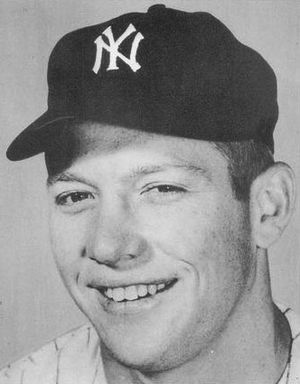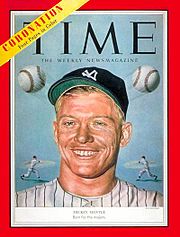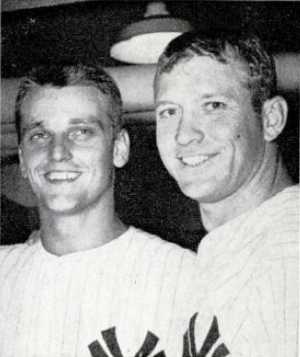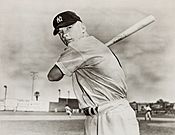Mickey Mantle facts for kids
Quick facts for kids Mickey Mantle |
|||
|---|---|---|---|

Mantle in 1957
|
|||
| Center fielder | |||
| Born: October 20, 1931 Spavinaw, Oklahoma, U.S. |
|||
| Died: August 13, 1995 (aged 63) Dallas, Texas, U.S. |
|||
|
|||
| debut | |||
| April 17, 1951, for the New York Yankees | |||
| Last appearance | |||
| September 28, 1968, for the New York Yankees | |||
| MLB statistics | |||
| Batting average | .298 | ||
| Hits | 2,415 | ||
| Home runs | 536 | ||
| Runs batted in | 1,509 | ||
| Teams | |||
|
|||
| Career highlights and awards | |||
|
|||
| Induction | 1974 | ||
| Vote | 88.2% (first ballot) | ||
Mickey Charles Mantle (October 20, 1931 – August 13, 1995) was a famous American baseball player. He was often called "the Commerce Comet" or "the Mick". Mantle played his entire career (1951–1968) for the New York Yankees in Major League Baseball (MLB). He was a center fielder, right fielder, and first baseman.
Many people consider Mantle one of the greatest players and sluggers ever. He is also seen as the best switch hitter (someone who can bat both left-handed and right-handed) in baseball history. Mantle was inducted into the Baseball Hall of Fame in 1974. In 1999, he was chosen for the Major League Baseball All-Century Team, which honors the best players of the 20th century.
Mantle was an amazing offensive player. He hit 536 career home runs and had a batting average of .300 or higher ten times. He holds the record (tied with Jim Thome) for the most walk-off home runs, with 13. He is the only player to hit 150 home runs from both sides of the plate. Mantle was also known for hitting "tape-measure home runs," a term created after one of his incredibly long home runs in 1953. He was also very good at avoiding double plays.
Mantle won the Triple Crown in 1956. This means he led the major leagues in batting average (.353), home runs (52), and runs batted in (RBI) (130) in the same season. He wrote a book called My Favorite Summer 1956 about that amazing year. He was an All-Star for 16 seasons and won the American League (AL) Most Valuable Player (MVP) award three times. He also won a Gold Glove once. Mantle played in 12 World Series and won seven championships. He holds World Series records for the most home runs (18), RBIs (40), and runs (42).
Contents
Early Life
Mickey Mantle was born on October 20, 1931, in Spavinaw, Oklahoma. His parents were Lovell and Elvin Charles "Mutt" Mantle. Mutt named his son after Mickey Cochrane, a famous baseball catcher. Mickey loved his father very much.
Mantle learned to switch-hit from a young age. His father would pitch to him right-handed, and Mickey would bat left-handed. His grandfather, Charles Mantle, would pitch left-handed, and Mickey would bat right-handed. His father passed away in 1952 when Mickey was only 20 years old.
When Mantle was four, his family moved to Commerce, Oklahoma. His father worked in lead and zinc mines there. Mickey loved baseball and was also a great athlete at Commerce High School. He played basketball and football. He was so good at football that the Oklahoma team offered him a scholarship.
However, a football injury almost ended his sports career. In his second year of high school, he was kicked in the shin during a practice game. He developed an infection called osteomyelitis in his left ankle. Luckily, new medicine called penicillin helped reduce the infection and saved his leg from being amputated.
Professional Baseball Career
Starting in the Minor Leagues (1948–1950)
Mantle began his professional baseball journey in Kansas with a semi-professional team called the Baxter Springs Whiz Kids. In 1948, a scout for the Yankees named Tom Greenwade came to watch one of Mantle's teammates. During that game, Mantle hit three home runs!
Greenwade returned in 1949 after Mantle finished high school and signed him to a minor league contract. Mantle earned $140 a month and received a $1,500 signing bonus.
Mantle started playing shortstop for the Independence Yankees. When he had a tough time hitting, he called his father, wanting to quit. His father drove to Independence, Kansas, and convinced him to keep playing. Mantle then improved his hitting, finishing the season with a .313 batting average. In 1950, he moved up to the Joplin Miners and won the batting title with an amazing .383 average. He also hit 26 home runs and had 136 RBIs.
Playing for the New York Yankees (1951–1968)
Rookie Season: 1951
Mantle impressed everyone at the Yankees' training camp in 1951. The team's manager, Casey Stengel, decided to bring him straight to the major leagues as a right fielder. Mantle was given uniform number 6. This number showed that the Yankees expected him to be their next big star, following legends like Babe Ruth (#3), Lou Gehrig (#4), and Joe DiMaggio (#5).
After a short period of struggling, Mantle was sent to the Yankees' top minor league team, the Kansas City Blues. He felt frustrated and again thought about quitting. His father came to Kansas City and told him, "I thought I raised a man. I see I raised a coward instead. You can come back to Oklahoma and work the mines with me." This motivated Mantle, and he started playing much better, hitting .361 with 11 home runs.
Mantle was soon called back to the Yankees, this time wearing uniform number 7. He finished his rookie season hitting .267 with 13 home runs. In the 1951 World Series, Mantle was playing right field when he chased a fly ball hit by Willie Mays. He tripped over a drain pipe and badly injured his right knee. This was the first of many injuries that affected his career. He played the rest of his career with a torn ligament in his knee.
Becoming a Star: 1952–1964

After Joe DiMaggio retired in 1951, Mantle became the Yankees' full-time center fielder in 1952. He was chosen as an All-Star for the first time. In his first full World Series (1952), Mantle was a hitting star for the Yankees, helping them win the championship. He played center field until 1965, then moved to left field, and spent his last two seasons at first base.
Mantle had an incredible season in 1956. He called it his "favorite summer." He led the major leagues in batting average (.353), home runs (52), and runs batted in (130). This earned him the Triple Crown and his first of three Major League Baseball Most Valuable Player Awards. He also hit a home run in the All-Star Game that year. In Game 5 of the 1956 World Series, Mantle helped Don Larsen pitch a perfect game by making a great catch and hitting a home run. His amazing performance in 1956 earned him the Hickok Belt as the top American athlete of the year. He is the only player to win a Triple Crown as a switch hitter.
Mantle won his second MVP award in 1957. He had a career-high .365 batting average. The 1958 season started slowly for him due to a shoulder injury from the 1957 World Series. However, he played much better in the second half of 1958, helping his team reach the World Series again.
In the 1960 season, Mantle hit a home run that many believe is the longest in history. It went over the right-center field roof at Briggs Stadium and was estimated to have traveled 643 feet!
In 1961, Mantle became the highest-paid player in baseball, signing a $75,000 contract. His top salary later reached $100,000 in 1963.
The M&M Boys

During the 1961 season, Mantle and his teammate Roger Maris were known as the M&M Boys. They both chased Babe Ruth's record of 60 home runs in a single season. Mantle had challenged Ruth's record before in 1956, but fell short with 52 home runs.
The New York media often favored Mantle, who had learned to deal with the press. Maris, however, was seen as more difficult. Late in the 1961 season, Mantle had to go to the hospital because of an infection, which left Maris to break the record. Maris finished with 61 home runs, while Mantle ended the season with 54. Mantle still led the American League in runs scored and walks.
In 1962, Mantle played in 121 games and batted .321. Even though he missed 41 games, he won his third MVP award. In 1963, he broke his foot trying to catch a home run ball. He returned to play later that season.
In 1964, Mantle hit .303 with 35 home runs. In Game 3 of the 1964 World Series, he hit a walk-off home run that won the game for the Yankees. This home run was his 16th in a World Series, breaking Babe Ruth's record of 15. He hit two more home runs in that series, setting a new World Series record with 18. The Cardinals won the World Series in seven games.
Last Seasons: 1965–1968
Injuries slowed down both the Yankees and Mantle in the 1965 season. Mantle was still selected as an All-Star, but as a reserve player. In 1966, his batting average improved to .288. After that season, Mantle moved to first base. On May 14, 1967, Mantle became the sixth player to join the 500 home run club.
In his final season in 1968, Mantle hit .237 with 18 home runs. His lifetime batting average dropped just below .300 to .298, which bothered him. He was an All-Star in almost every season of his 18-year career.
Retirement: 1969
Mickey Mantle announced his retirement from baseball on March 1, 1969, at age 37. He gave a farewell speech on Mickey Mantle Day at Yankee Stadium on June 8, 1969. When he retired, Mantle was third on the all-time home run list with 536. He also held the Yankees' record for most games played with 2,401, a record later broken by Derek Jeter in 2011.
Player Skills
Powerful Hitting
Mantle hit some of the longest home runs in Major League history. On September 10, 1960, he hit a ball that cleared the right-field roof at Tiger Stadium. It was later estimated to have traveled 643 feet (196 m). Another home run he hit on April 17, 1953, was measured at 565 feet (172 m). These were truly "tape-measure home runs."
Mantle also hit balls off the third-deck facade at Yankee Stadium twice. On May 22, 1963, he hit a ball that many believed was still rising when it hit the 110-foot (34 m) high facade. It was estimated that it could have traveled 504 feet (154 m) if it hadn't been stopped.
Even though he hit more home runs batting left-handed, Mantle thought he was a better right-handed hitter. He hit .330 right-handed compared to .281 left-handed. The difference in home runs was because most pitchers are right-handed, so he batted left-handed more often.
Injuries
Mantle's career was often affected by injuries. From high school onward, he had many problems with his legs. Before games, he would wrap his knees tightly. By the end of his career, even swinging the bat caused him pain. Many people wonder how much more he could have achieved if he had stayed healthy.
As a 19-year-old rookie in his first World Series, Mantle tore a ligament in his right knee. This happened when he tripped over a drainage cover in the outfield. He was carried off the field and watched the rest of the series from a hospital bed. He played the rest of his career with this knee injury. Despite his injuries, Mantle was known as one of the fastest players to first base and won the Triple Crown in 1956.
Later Years
After retiring, Mantle worked as a part-time baseball commentator for NBC and the Montreal Expos.
In 1973, at an Old-Timers Game at Yankee Stadium, Mantle hit a towering home run over the 402-foot sign. Many consider this his last home run at Yankee Stadium.
Mantle became very involved in the sports memorabilia business in the 1980s. He was a popular guest at baseball card shows, signing autographs and meeting fans. He always made sure that other lesser-known Yankees players from his era were also invited to these events so they could earn money too.
In 1988, Mickey Mantle's Restaurant & Sports Bar opened in New York City. Mantle often visited the restaurant.
In 1983, Mantle worked for a casino in Atlantic City. Because of a rule about baseball players working with certain businesses, Baseball Commissioner Bowie Kuhn suspended him from baseball. However, he was allowed back into baseball by the next Commissioner, Peter Ueberroth, in 1985.
In 1992, Mantle wrote a book about his 1956 season called My Favorite Summer 1956.
Personal Life
On December 23, 1951, Mantle married Merlyn Johnson. They had four sons: Mickey Jr., David, Billy, and Danny. Billy was named after Mantle's good friend and teammate, Billy Martin. In 1980, Mantle and his wife lived apart for the rest of his life, but they never officially divorced.
In his final years, Mantle spent a lot of time in Greensboro, Georgia. He enjoyed the quiet town and how the people there respected his privacy.
Illness and Death
In early 1995, doctors found that Mantle had serious liver damage and a severe liver illness. He received a liver transplant on June 8, 1995, but it did not help much.
Mantle passed away on August 13, 1995, at the age of 63, with his wife and son David by his side. The Yankees honored him with a tribute on the day he died.
Mantle was buried in the Mantle Family Mausoleum in Dallas, Texas.
Honors
Mantle was inducted into the Oklahoma Hall of Fame in 1964.
 |
|
| Mickey Mantle's number 7 was retired by the New York Yankees in 1969. |
On Mickey Mantle Day at Yankee Stadium on June 8, 1969, his uniform number 7 was retired. He was also given a bronze plaque to be placed on the center field wall, near monuments to other Yankees legends like Babe Ruth and Lou Gehrig. Joe DiMaggio presented the plaque to Mantle. Mantle then gave a similar plaque to DiMaggio, saying, "Joe DiMaggio's deserves to be higher." Because of this, DiMaggio's plaque was hung one inch higher than Mantle's. These plaques are now in Monument Park at the current Yankee Stadium.
Shortly before he passed away, Mantle recorded a message for Old-Timers' Day, which he was too ill to attend. He said, "When I die, I wanted on my tombstone, 'A great teammate.' But I didn't think it would be this soon." These words were later carved on his monument in Monument Park.
Mantle and his former teammate Whitey Ford were both elected to the Baseball Hall of Fame in 1974.
Since 1997, the Topps Baseball Card company has retired card number 7 in its main baseball card sets to honor Mantle. Mantle's baseball cards, especially his 1952 Topps rookie card, are very popular and valuable among collectors. In August 2022, a 1952 card sold for $12.6 million, setting a record for sports memorabilia at the time.
In 1998, The Sporting News ranked Mantle 17th on its list of baseball's 100 greatest players. He was also chosen by fans as one of the outfielders for the Major League Baseball All-Century Team.
A school in Manhattan was renamed for Mantle on June 4, 2002. In 2006, Mantle was featured on a United States postage stamp.
A statue of Mantle stands at Mickey Mantle Plaza in Oklahoma City, at the home stadium of the Triple-A Oklahoma City Dodgers.
Awards and Achievements
| Award/Honor | # of Times | Dates | Refs |
|---|---|---|---|
| All-Star | 20 | 1952, 1953, 1954, 1955, 1956, 1957, 1958, 1959 (19591, 19592), 1960 (19601, 19602), 1961 (19611, 19612), 1962 (19621, 19622), 1963, 1964, 1965, 1967, 1968 | |
| American League batting champion | 1 | 1956 | |
| American League home run champion | 4 | 1955, 1956, 1958, 1960 | |
| American League MVP Award | 3 | 1956, 1957, 1962 | |
| American League Gold Glove Award | 1 | 1962 | |
| American League Triple Crown | 1 | 1956 | |
| Associated Press Male Athlete of the Year | 1 | 1956 | |
| Hickok Belt | 1 | 1956 | |
| Hutch Award | 1 | 1965 | |
| World Series champion | 7 | 1951, 1952, 1953, 1956, 1958, 1961, 1962 |
Images for kids
-
Joe DiMaggio and Mantle at Yankee Stadium in 1970.
See also
 In Spanish: Mickey Mantle para niños
In Spanish: Mickey Mantle para niños








